Navigation
Research, Development and Commercialization of the Kenya Ceramic Jiko and other Improved Biomass Stoves in Africa
There has been a combination of local input and international agency involvement, along with many others, who participated in developing The Kenya Ceramic Jiko (KCJ).
The stove is a portable improved charcoal burning stove consisting of an hour-glass shaped metal cladding with an interior ceramic liner that is perforated to permit the ash to fall to the collection box at the base. A thin layer of vermiculite or cement is placed between the cladding and the liner. A single pot is placed on the rests at the top of the stove.
Location:
Primary location, Kenya
Problem Overview:
Environmental and health problems due to use of wood and charcoal-burning stoves
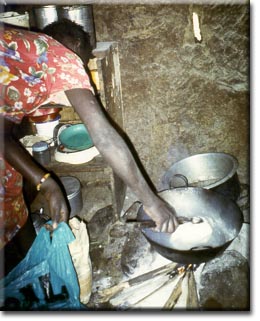 |
There are many problems confronting people and the environment from the use of wood and charcoal-burning stoves: heavy labor finding, cutting and carrying wood, usually by women and girls; degradation of the environment from loss of trees and resulting erosion and habitat destruction; emissions of products of incomplete combustion including carbon monoxide, nitrogen and sulfur oxides and various organic compounds as well as particulate matter; and, the health damage inflicted by particulate matter which contributes to acute respiratory infection —the leading cause of illness in developing nations.
There has been a combination of local input and international agency involvement, along with many others, who participated in developing The Kenya Ceramic Jiko (KCJ).
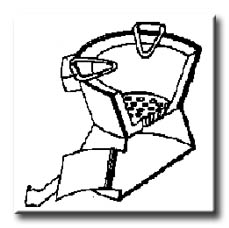 |
The stove is a portable improved charcoal burning stove consisting of an hour-glass shaped metal cladding with an interior ceramic liner that is perforated to permit the ash to fall to the collection box at the base. A thin layer of vermiculite or cement is placed between the cladding and the liner. A single pot is placed on the rests at the top of the stove.
The KCJ is the result of research on stove design, efficiency, and patterns of usage initiated in the 1970's and actively continued through the 1980's (Kinyanjui and Minae, 1982; Openshaw, 1982; Barnes et al., 1994; Kammen, 1995a,b).
The KCJ has been promoted by local and international agencies. There are now more than 200 businesses, artisans, and micro-enterprise or informal sector manufacturers producing over 13,000 stoves each month. There are over 700,000 KCJ's in use in Kenya (Walubengo, 1995); the stoves are found in over 50% of all urban homes, and roughly 16% of rural homes. The general features of the KCJ program and the stove design itself have both been the utilized in formulating improved biomass stove programs in a number of African nations. The ovens are now in use in more than 30 nations.
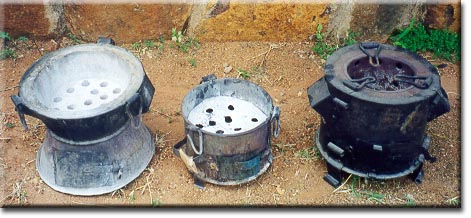 |
If used and maintained properly, the KCJ can reduce fuel use by 30 - 50%, although not surprisingly there is considerable variation based on the extent of training and outreach efforts, stove quality, and cooking practices. The KCJ also reduces emissions of products of incomplete combustion (carbon monoxide, nitrogen and sulfur oxides and various organic compounds), as well as particulate matter, the latter of which contributes to acute respiratory infection, the leading cause of illness in developing nations. Quantifying the degree of emissions reductions in actual home conditions is an ongoing area of study, with estimates of 20% in the literature
(Karekezi and Ranja, 1997).
A formal private sector company, Jerri International, served as the initial manufacturer of the KCJ. This arrangement was subject to debate, and KCJ production then evolved into two, often related, informal sector activities: production of the metal cladding by artisans who were generally already producing traditional metal stoves in Kenya; and production of the ceramic liner, which is produced in a number of regional or rural clay and pottery workshops and factories.
Since 1982 the Kenya Energy and Environment Organization (KENGO) has organized promotion and outreach efforts to encourage the use of the KCJ. A number of foundations, including CARE, UNICEF, and the Bellerive Foundation have all played roles in the evolution of the stove and the stove dissemination process, as has the U. S. (US AID) and German (GTZ) aid and development organizations. The Foundation for Woodstove Dissemination has worked both within Kenya and internationally as the coordinator of a network of stove researchers, promoters, and dissemination specialists.
As outlined above, the KCJ evolved through the efforts of a number of public and private sector organizations with interests in aid, development, health, and environmental conservation. Feedback from groups of users, including women's cooperatives
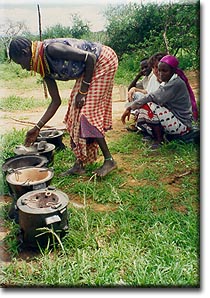 |
The process of research, development, demonstration and then commercialization that led first to the KCJ and then to other stove models in Kenya was seeded by international and local development funds. After explicit consideration a decision was made not to directly subsidize commercial stove production and dissemination. Initially stoves were expensive (~ US$ 15/stove), sales were slow, and the quality was variable. Continued research and refinement, and expanded numbers and types of manufacturers and vendors increased competition, and spurred innovations in materials used and in production methods. The wholesale and retail network for stoves is now extensive. The KCJ can be purchased in a variety of sizes. Prices for KCJ models have decreased to roughly US$ 1 - 3 depending on stove size, design and quality (Kammen, 1995a; Walubengo, 1995). This decrease is consistent with the 'learning curve' theory of price reductions through innovations that result from experience gained in the manufacturing, distribution, marketing and sales process.
The ceramic liner of the KCJ degrades over time, and needs to be replaced. Street vendors of stoves, and many of the larger stove sales outlets take 'used' stoves back, discounting the purchase of a new stove. The liners of the old stove are then removed, the metal cladding is repaired, if needed, and the stove is reassembled, repainted, and resold. This process has also served to involve a wider informal sector economy in the stove process.
Reductions in fuel use associated with the KCJ and other improved stoves have been examined in a number of countries. In Kenya charcoal use among a sample of families using the KCJ fell from 0.67 to 0.39 kg/charcoal/day. This totals over 600 kg of charcoal/year for an average family, and a savings of over $US 60/year. A study in Rwanda prior to the war found charcoal use fell from 0.51 kg/person/day to 0.33 with the use of improved stoves. Personal incomes in Kenya and Rwanda average $300 - 400/year (Karekezi and Ranja, 1997).
Process used to Select Technologies for Use in the Project
The KCJ is derived from a 'bucket' stove that a team of Kenyan researchers examined in Thailand, and then was successively adapted to east African cooking practices. The stove has continued to evolve in response to usage, metal fatigue and other tests, as well as in response to feedback from stove users.
Types of Training/Support Involved
KCJ production and dissemination was not financially subsidized although a number of Kenyan and international groups have been active in stove promotion through campaigns based on stove convenience, reduced fuel use, improved health and safety. These same groups have also conducted training courses for stove manufacturers, vendors, and end-users.
The KCJ project faced a number of important barriers, including: the view held by some researchers and dissemination groups (Kammen, 1995b) that there could be a bias against changing the cooking style at all; the need to promote the stove as fuel saving despite higher initial costs; and the need to conduct training and support services for a seemingly 'simple' household technology. A success and a drawback of the stove program is the network of often informal sector manufacturers and vendors. On the one hand, the direct and grass-roots commercialization fully integrates the KCJ into the local economy. On the other hand, quality and price variations in the stoves produced in such diverse settings can be great, including a number of clearly sub-standard models. Stoves manufactured poorly rarely stay in the market for long, but opinion of the stoves, and individual bad experiences can color the future interest of potential users.
Benefits to Recipient/Provider
The KCJ provides a number of important benefits to the end user, reduced requirements for fuel, reduced pollutant exposure, and even greater safety for children as the ceramic lined stove is less of a threat to burn on accidental contact. The KCJ program has also increased employment in the stove and informal ceramic industry.
The KCJ process has focused attention on the trade-offs between development 'project' and commercial sector management of a technology, and highlights the potential to involve the informal sector. At the same time, it has become clear that there is an important role for cooperative projects where government, NGO, or other organizations provide training, outreach services, publicity, and other logistical support for the local commercial industry.
Assessment of Possibilities for Replicating the Process Described
The KCJ stove design has now been transferred, or has been the model for locally adapted stove designs or initiatives, in a number of other nations, including Ethiopia, Malawi, Niger, Rwanda, Senegal, Sudan, and Uganda (see Table 1). Extension and support for this process, as well as opportunities for exchange of technical information and lessons in the dissemination process between countries and regions with active, or planned, stove programs is also an important area where international support can be of tremendous value.
Implementation and adaptation of the KCJ stove experience between nations is only one component of the potential for program replication. The population of sub-Saharan Africa is largely rural; in Kenya, for example, over 80% of the population lives in rural areas. The KCJ is a charcoal stove, while much of the rural population uses wood. A number of improved stoves that burn wood have been developed, in many cases by the same organizations involved in the KCJ research and dissemination process. These programs focus on more robust, lower cost stoves and have different requirements for the stove walls, the openings for the fuel and for ash removal. Integrating lessons from the charcoal and woodfuel stoves is an important means to support and expand both programs.
The issue of health improvements is a major issue: despite 20+ years and 150 cookstove projects, no detailed, scientific studies of the health impacts have been done -- yet. I have a large project in Kenya (staff of 9; 500 people in the study population, health exams every week for everyone ...) that is looking into that question.
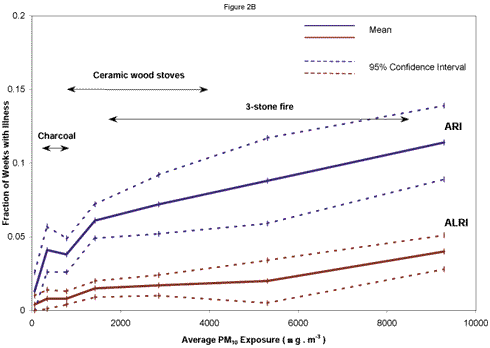 |
International Involvement
What can the international community do to facilitate technology transfer of climate-friendly technologies? The lessons for international involvement that can be drawn from the KCJ case include:
- Support for research both within developing nations and for research collaborations between developing nations can lead to significant innovations in the technology and in the entire production and commercialization process.
- Extended, stable, program support is invaluable while short-lived, episodic funding can lead to waste and inefficiency and the need for re-learning and duplication of effort. There are significant technical, social, cultural and economic questions that must be addressed even for technologies that may appear to be simple (Kammen and Dove, 1997). At the same time, long-term support is most effective if safeguards against complacency and dependency are instituted from the outset.
- Support for stove programs need not take the form of direct subsidies. Partnerships between institutional groups, including NGOs and international organizations, involved in R&D, promotion, and training can be decoupled from commercial production and sales as long as the mechanisms for feedback, cooperation and public to private sector spillover are explicitly addressed.
Anticipated or known documentation endeavors:
KQED-TV San Francisco, California, USA, an affiliate of PBS, produced a program about the stoves, "Green Means: Episode #213.
Organization Reference People:
Stephen Karekezi
Executive Secretary AFREPREN/FWD FWD House Ole Odume House Foundation for Woodstove Dissemination Kilimani
P. O. Box 30979 Nairobi, Kenya
Tel: (254) 2-566032
Fax: (254) 2-561464 & 740524
Email: Skarekezi@form-net.com
Matthew Owens,
Bellerive Foundation
Ngong Road, P. O. Box 42994
Nairobi, Kenya
Tel: (254) 2-72074
Fax: (254) 2-726547
Dominic Walubengo
Associate Director Kenya Energy and Environment Organization
P. O. Box 48197
Nairobi, Kenya
Tel: (254) 2-749747 & 748281
Fax: (254) 2-749382
Barnes, D. F., Openshaw, K., Smith, K. and van der Plas, R. (1994) What makes people cook with improved biomass stoves? (World Bank Technical Paper No. 242: Energy Series).
Duke, R. D., and Kammen, D. M. (1998) "Evaluating demand-side technology commercialization programs: Integrating experience curves and demand theory", The Energy Journal, in review.
Kammen, D. M. (1995a) "Cookstoves for the developing world," Scientific American, 273, 72 - 75.
Kammen, D. M. (1995b) "From energy efficiency to social utility: Improved cookstoves and the Small is Beautiful model of development," in Energy as an Instrument for Socio-Economic Development, Goldemberg, J. and Johansson, T. B. (eds.) (United Nations Development Programme: New York), 50 - 62.
Karekezi, S. and Ranja, T. (1997) Renewable Energy Technologies in Africa (African Energy Policy Research Network/SEI and Zed Books: London).
Kinyanjui, M. and Minae, S. (1982) "Extension/training programme in renewable energy technology: an implementation strategy," Kenya Renewable Energy Development Project (KREDP: Nairobi, Kenya).
Openshaw, K. (1982) "The development of improved cooking stoves for urban and rural households in Kenya," Report of the Beijer Institute (Beijer Institute/Royal Swedish Academy of Sciences: Stockholm, Sweden).
Reddy, A. K. N., Williams, R. H. and Johansson, T. B. (1997) Energy After Rio: Prospects and Challenges (UNDP: New York).
Walubengo, D. (1995) "Commercialization of improved stoves: The case of the Kenya Ceramic Jiko (KCJ)", in Stove Images: A Documentation of Improved and Traditional Stoves in Africa, Asia, and Latin America, Westhoff, B. and Germann, D. (eds.), (Commission of the European Communities: Brussels, Belgium).
Web Links:
Description | web_address |
Daniel Kammen's web site | http://kammen.berkeley.edu/ |
| In-depth Solution Presentation | Click here |
Documentation:
KQED-TV San Francisco, California, USA, an affiliate of PBS, produced a program about the stoves, "Green Means: Episode #213.
Submitted by:
Daniel M. Kammen, Ph.D.
Associate Professor of Energy and Society
Director, Renewable and Appropriate Energy
Laboratory (RAEL)
Energy and Resources Group (ERG)
310 Barrows Hall
University of California
Berkeley, CA 94720-3050
Tel: 510-642-1139 (office)
Tel: 510-642-1640 (ERG Front Desk)
Fax: 510-642-1085
Email: kammen@berkeley.edu
WWW: http://berkeley.edu
Additional Contacts:
Bellerive Foundation
Matthew Owens
P. O. Box 42994
Ngong Road, Nairobi, Kenya
Tel: (254) 2-72074
Fax: (254) 2-726547
Kenya Energy and Environment Organization
Dominic Walubengo, Associate Director
P. O. Box 48197, Nairobi, Kenya
Tel: (254) 2-749747, (254) 2-748281
Fax: (254) 2-749382
- Login to post comments

Search
Latest articles
Agriculture
- World Water Week: Healthy ecosystems essential to human health: from coronavirus to malnutrition Online session Wednesday 24 August 17:00-18:20
- World Water Week: Healthy ecosystems essential to human health: from coronavirus to malnutrition Online session Wednesday 24 August 17:00-18:20
Air Pollution
- "Water and Sanitation-Related Diseases and the Changing Environment: Challenges, Interventions, and Preventive Measures" Volume 2 Is Now Available
- Global Innovation Exchange Co-Created by Horizon International, USAID, Bill and Melinda Gates Foundation and Others
Biodiversity
- It is time for international mobilization against climate change
- World Water Week: Healthy ecosystems essential to human health: from coronavirus to malnutrition Online session Wednesday 24 August 17:00-18:20
Desertification
- World Water Week: Healthy ecosystems essential to human health: from coronavirus to malnutrition Online session Wednesday 24 August 17:00-18:20
- UN Food Systems Summit Receives Over 1,200 Ideas to Help Meet Sustainable Development Goals
Endangered Species
- Mangrove Action Project Collaborates to Restore and Preserve Mangrove Ecosystems
- Coral Research in Palau offers a “Glimmer of Hope”
Energy
- Global Innovation Exchange Co-Created by Horizon International, USAID, Bill and Melinda Gates Foundation and Others
- Wildlife Preservation in Southeast Nova Scotia
Exhibits
- Global Innovation Exchange Co-Created by Horizon International, USAID, Bill and Melinda Gates Foundation and Others
- Coral Reefs
Forests
- NASA Satellites Reveal Major Shifts in Global Freshwater Updated June 2020
- Global Innovation Exchange Co-Created by Horizon International, USAID, Bill and Melinda Gates Foundation and Others
Global Climate Change
- It is time for international mobilization against climate change
- It is time for international mobilization against climate change
Global Health
- World Water Week: Healthy ecosystems essential to human health: from coronavirus to malnutrition Online session Wednesday 24 August 17:00-18:20
- More than 400 schoolgirls, family and teachers rescued from Afghanistan by small coalition
Industry
- "Water and Sanitation-Related Diseases and the Changing Environment: Challenges, Interventions, and Preventive Measures" Volume 2 Is Now Available
- Global Innovation Exchange Co-Created by Horizon International, USAID, Bill and Melinda Gates Foundation and Others
Natural Disaster Relief
- STOP ATTACKS ON HEALTH CARE IN UKRAINE
- Global Innovation Exchange Co-Created by Horizon International, USAID, Bill and Melinda Gates Foundation and Others
News and Special Reports
- World Water Week: Healthy ecosystems essential to human health: from coronavirus to malnutrition Online session Wednesday 24 August 17:00-18:20
- STOP ATTACKS ON HEALTH CARE IN UKRAINE
Oceans, Coral Reefs
- World Water Week: Healthy ecosystems essential to human health: from coronavirus to malnutrition Online session Wednesday 24 August 17:00-18:20
- Mangrove Action Project Collaborates to Restore and Preserve Mangrove Ecosystems
Pollution
- Zakaria Ouedraogo of Burkina Faso Produces Film “Nzoue Fiyen: Water Not Drinkable”
- "Water and Sanitation-Related Diseases and the Changing Environment: Challenges, Interventions, and Preventive Measures" Volume 2 Is Now Available
Population
- "Water and Sanitation-Related Diseases and the Changing Environment: Challenges, Interventions, and Preventive Measures" Volume 2 Is Now Available
- "Water and Sanitation-Related Diseases and the Changing Environment: Challenges, Interventions, and Preventive Measures" Volume 2 Is Now Available
Public Health
- Honouring the visionary behind India’s sanitation revolution
- Honouring the visionary behind India’s sanitation revolution
Rivers
- World Water Week: Healthy ecosystems essential to human health: from coronavirus to malnutrition Online session Wednesday 24 August 17:00-18:20
- Mangrove Action Project Collaborates to Restore and Preserve Mangrove Ecosystems
Sanitation
- Honouring the visionary behind India’s sanitation revolution
- Honouring the visionary behind India’s sanitation revolution
Toxic Chemicals
- "Water and Sanitation-Related Diseases and the Changing Environment: Challenges, Interventions, and Preventive Measures" Volume 2 Is Now Available
- Actions to Prevent Polluted Drinking Water in the United States
Transportation
- "Water and Sanitation-Related Diseases and the Changing Environment: Challenges, Interventions, and Preventive Measures" Volume 2 Is Now Available
- Urbanization Provides Opportunities for Transition to a Green Economy, Says New Report
Waste Management
- Honouring the visionary behind India’s sanitation revolution
- Honouring the visionary behind India’s sanitation revolution
Water
- Honouring the visionary behind India’s sanitation revolution
- Honouring the visionary behind India’s sanitation revolution
Water and Sanitation
- Honouring the visionary behind India’s sanitation revolution
- Honouring the visionary behind India’s sanitation revolution

